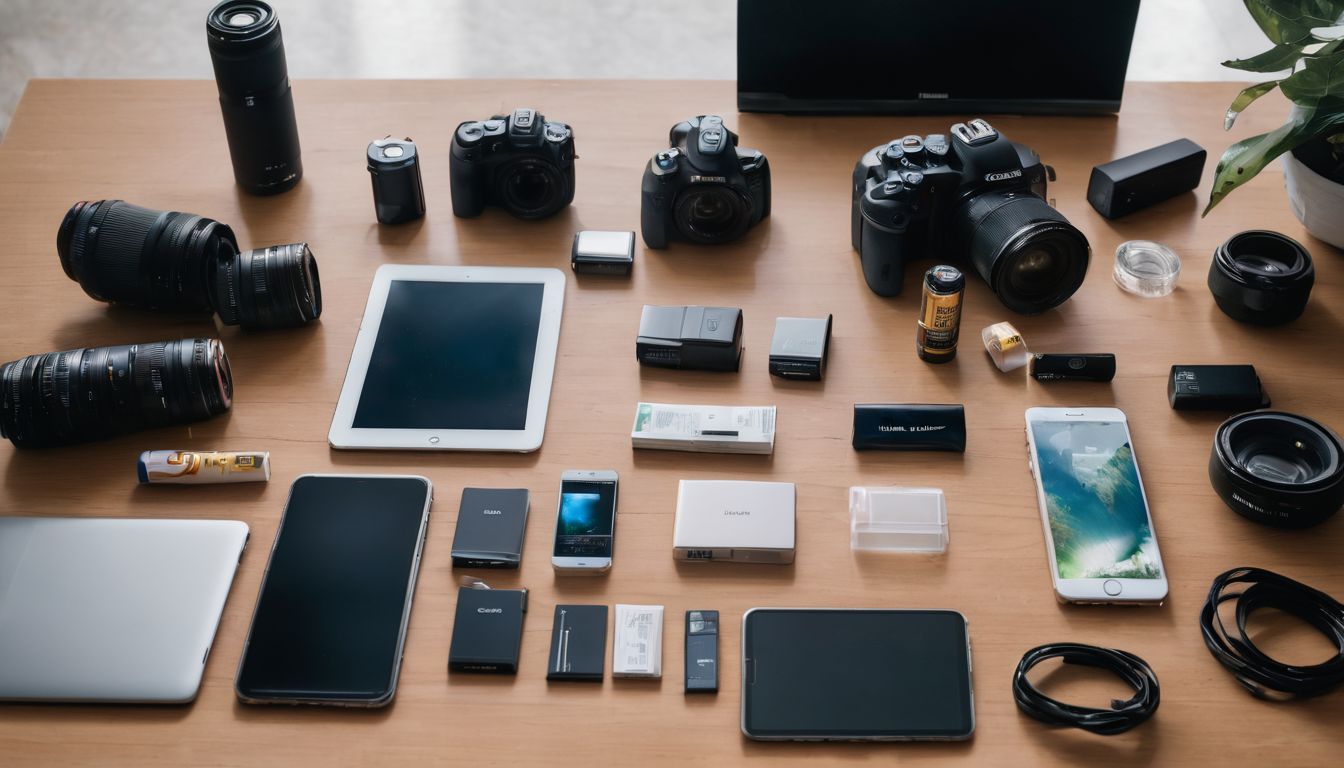We all yearn to shave a few quid off our electricity bills whilst doing our bit for the environment, don’t we? Much like you, we’ve navigated through the bewildering array of light bulbs on the market, all touting their ‘green’ credentials.
After extensive research and digging deep into the subject, we’ve uncovered that by switching to particular eco-friendly bulbs, an average household could see energy usage plummet by up to 80%.
So let’s shed some light on your options and help you make smarter choices that will not only increase your savings but also be kinder to our dear planet—carry on reading!
Key Takeaways
- Choose ENERGY STAR certified bulbs for guaranteed energy savings and reduced environmental impact. These bulbs undergo strict testing to meet high performance and longevity standards.
- Opt for LED or CFL light bulbs as they use significantly less energy compared to traditional incandescent bulbs. They also have a prolonged lifespan, leading to fewer replacements and decreased waste generation over time.
- Understand the difference between lumens and watts when selecting light bulbs: lumens measure light output while watts measure energy consumption. Aim for high lumens with low wattage for bright lighting that’s efficient on power usage.
- Incorporate smart technology compatibility with your eco-friendly light bulbs to control and optimise their use through smartphones or voice-controlled systems, further enhancing sustainability at home.
- Utilise natural light wherever possible by strategically placing eco – friendly lightbulbs, which helps in reducing reliance on artificial lighting during daylight hours, saving energy and costs.
Benefits of Switching to Eco-Friendly Light Bulbs
Switching to eco-friendly light bulbs offers reduced energy consumption and longer lifespan, ultimately leading to cost savings in the long run. These bulbs also have a lower environmental impact compared to traditional incandescent bulbs.
Reduced energy consumption
We understand that saving energy is crucial for a sustainable future, which is precisely what eco-friendly light bulbs help us achieve. By choosing LED or CFL over traditional incandescent bulbs, we dramatically lower the amount of electricity used to light our homes.
It’s not just about doing good for the planet; it also means fewer trips to change the bulb and more money left in our pockets.
Opting for these energy-efficient options means we’re part of a positive change. The reduced energy consumption from using LEDs or CFLs lessens the demand on power plants and cuts greenhouse gas emissions significantly.
We’re embracing efficiency with every flick of the switch, creating brighter homes while dimming our environmental impact.
Longer lifespan
When considering eco-friendly light bulbs, it’s important to take into account the longer lifespan of these sustainable options. LED and CFL bulbs have a significantly longer life expectancy compared to traditional incandescent bulbs, reducing the frequency of replacement and contributing to lower waste generation.
Opting for light bulbs with extended lifespans not only saves you money in the long run but also minimises environmental impact by decreasing the demand for manufacturing and disposal of new bulbs.
By choosing energy-efficient options such as LEDs or CFLs, you are making a conscious choice towards sustainability and energy conservation at home.
Cost savings
Switching to eco-friendly light bulbs can lead to significant cost savings over time. LED and CFL bulbs may have a higher initial purchase price, but they consume less energy and last much longer than traditional incandescent bulbs.
This means that you will spend less on replacement bulbs and see a noticeable reduction in your electricity bills.
By investing in environmentally friendly lighting options, such as LED or CFL bulbs, individuals can enjoy substantial long-term cost savings without compromising on the quality of light in their homes or workplaces.
Types of Eco-Friendly Light Bulbs
When it comes to eco-friendly light bulbs, there are several options to choose from. Halogen incandescent light bulbs, compact fluorescent lamps (CFL), and light-emitting diodes (LED) are all great choices for energy-efficient lighting.
Halogen Incandescent Light Bulbs
Halogen incandescent light bulbs provide a warm, bright light and can be used with dimmers. These bulbs are more efficient than traditional incandescent bulbs and last longer, making them a sustainable lighting choice.
When choosing halogen incandescent bulbs, look for the ENERGY STAR certification to ensure energy efficiency and quality.
Halogen incandescent light bulbs emit a white light that closely resembles natural daylight. They are suitable for various settings in the home, such as kitchens, bathrooms, or workspaces where clear visibility is essential.
Compact Fluorescent Lamps (CFL)
Now, moving on to Compact Fluorescent Lamps (CFL), these bulbs have gained popularity for their energy efficiency and environmentally friendly features. CFLs use up to 75% less energy than traditional incandescent bulbs, making them an excellent choice for reducing electricity consumption.
With a longer lifespan of around 10 times that of incandescent bulbs, they not only save you money in the long run but also contribute to a greener environment by reducing waste. Additionally, CFLs produce the same amount of light as incandescent bulbs but with lower power usage, contributing significantly to electricity savings while providing sustainable lighting choices for your home or workspace.
CFLs are one of the top energy-efficient bulb options available today and are ideal for those seeking low-impact light bulbs without compromising on brightness or quality. When considering sustainability in lighting choices, CFLs emerge as a reliable and eco-conscious option that helps lessen environmental impact while supporting conservation efforts.
Light-Emitting Diodes (LED)
LED bulbs are an excellent choice for eco-friendly lighting. They consume significantly less energy than traditional incandescent bulbs, helping to reduce electricity bills and lower carbon emissions.
LED bulbs also have a longer lifespan, lasting up to 25 times longer than incandescent bulbs, thus reducing the frequency of replacements and minimising waste. Their efficiency is evident in their low power rating, providing sustainable lighting solutions for environmentally conscious individuals.
When selecting LED bulbs, look for ENERGY STAR certified options that meet high-quality standards for performance and efficiency. Additionally, consider the purpose and placement of the bulb to ensure optimal use and energy savings.
Comparing Energy Efficiency
When comparing energy efficiency, it’s important to consider lumens vs. watts for cost and energy savings. To learn more about selecting environmentally friendly light bulbs, keep reading!
Lumens vs. Watts
Understanding the difference between lumens and watts is crucial when we’re selecting eco-friendly light bulbs. Watts measure the energy consumption of the bulb, while lumens indicate the amount of light emitted. For a long time, we’ve associated bulb brightness with watts, but as we move towards more energy-efficient lighting, lumens become the key indicator of a bulb’s brightness.
Here’s a simplified comparison in an HTML table format:
| Measurement | Definition | Importance for Eco-Friendly Lighting |
|---|---|---|
| Lumens | The amount of light the bulb emits. | Higher lumens mean brighter light. To save energy, look for a bulb with more lumens and less wattage. |
| Watts | The amount of energy the bulb uses. | Lower watts indicate lower energy consumption. This means savings on our energy bills and less environmental impact. |
We always aim to select a bulb with the highest lumens and the lowest watts, ensuring we get the brightness we need while keeping our energy use to a minimum. Knowing this helps us make informed decisions when purchasing light bulbs that are kinder to the environment.
Next, we’ll explore cost and energy savings associated with making the switch to eco-friendly lighting.
Cost and energy savings
Transitioning from understanding the difference between lumens and watts to considering cost and energy savings, it is essential for environmentally conscious individuals to weigh the long-term benefits of eco-friendly light bulbs. By choosing energy-efficient options such as LED or CFL bulbs, one can significantly reduce electricity bills due to their lower power consumption. Similarly, these bulbs have a longer lifespan than traditional incandescent ones, translating into savings on replacement costs and reduced environmental impact through less frequent disposal.
When exploring sustainable lighting options, it’s crucial to calculate the total cost of ownership over time rather than just upfront expenses. Energy-efficient bulbs might have a slightly higher initial price but offer substantial long-term savings through decreased energy usage and extended lifespans. Additionally, utilising environmentally friendly light bulbs contributes to conservation efforts by reducing overall energy demand and greenhouse gas emissions—empowering individuals with an easy yet impactful way to support sustainability.
How to Choose the Right Eco-Friendly Light Bulbs
Look for ENERGY STAR certified bulbs, consider the purpose and placement of the bulb, and determine the wattage needed to make an informed decision about your eco-friendly lighting.
To learn more about selecting environmentally friendly light bulbs, keep reading!
Look for ENERGY STAR certified bulbs
When choosing environmentally friendly light bulbs, one of the most crucial factors to consider is whether they are ENERGY STAR certified. This certification ensures that the bulb meets strict energy efficiency guidelines set by the Environmental Protection Agency.
By opting for ENERGY STAR certified bulbs, you can be assured of maximum energy savings and reduced environmental impact. Additionally, these bulbs undergo rigorous testing to ensure that they meet high standards for performance and longevity, providing you with both eco-friendliness and cost-effectiveness.
Selecting lighting options with an ENERGY STAR label guarantees not only reduced energy consumption but also long-lasting performance, making them an ideal choice for anyone seeking sustainable and efficient lighting solutions at home or in commercial spaces.
Consider the purpose and placement of the bulb
When choosing eco-friendly light bulbs, we should consider the purpose and placement of each bulb in our home. Different areas may require varying levels of brightness, such as bright white light for workspaces or warm yellow light for living areas.
It’s also essential to factor in the size and style of fixtures when selecting bulbs to ensure a seamless fit. By evaluating these aspects, we can make informed decisions that align with our energy-efficient goals while creating the desired atmosphere within our living spaces.
Determining the wattage needed helps us select bulbs that provide optimal lighting without unnecessary energy consumption. This will enable us to save on electricity costs and reduce our environmental impact by using only the necessary amount of energy.
Determine the wattage needed
To determine the wattage needed, consider the purpose and location of the light bulb. Assessing the level of brightness required for a particular area will help in selecting the right wattage.
Also, factor in any dimming requirements or specific lighting needs to ensure that you choose an eco-friendly bulb with appropriate wattage for optimal energy efficiency.
When determining the wattage needed, look for ENERGY STAR certified bulbs and compare lumens to watts ratio. This comparison can guide you towards choosing an environmentally friendly light bulb that meets your energy-saving goals while providing adequate illumination for your space.
Other Factors to Consider
When selecting environmentally friendly light bulbs, it’s important to consider recycled fixtures, smart technology compatibility, and natural light optimisation. These factors can contribute to a more sustainable and energy-efficient lighting solution for your home or workplace.
Recycled fixtures
When choosing eco-friendly light bulbs, consider pairing them with recycled fixtures. These fixtures are made from reclaimed or repurposed materials, reducing the demand for new resources and minimising environmental impact.
By opting for recycled fixtures alongside energy-efficient bulbs, you can further contribute to sustainability in your lighting choices.
Incorporating recycled fixtures into your lighting design not only supports environmental conservation but also adds a unique and stylish touch to your living space. Look for fixtures made from sustainable materials like reclaimed wood or upcycled metal to enhance the visual appeal of your eco-friendly lighting setup.
Smart technology compatibility
When considering eco-friendly lighting options, it’s important to look for bulbs that are compatible with smart technology. This compatibility allows you to integrate your lighting system with smart home devices, enabling you to control and automate your lights for maximum energy efficiency.
By choosing environmentally conscious light bulbs that work seamlessly with smart technology, you can further reduce energy consumption and contribute to a sustainable home environment.
Additionally, by utilising this feature with eco-conscious LED bulbs or CFL light bulbs, you empower yourself in creating an energy-efficient lighting solution tailored to your specific needs.
Natural light optimisation
When considering environmentally friendly lighting options, natural light optimisation is a crucial factor to keep in mind. Positioning eco-friendly light bulbs strategically to make the most of natural light sources can reduce the need for artificial lighting during daylight hours.
This not only minimises energy consumption but also contributes to significant cost savings over time. By aligning the placement and purpose of eco-friendly light bulbs with natural light sources, homeowners can enhance sustainability efforts while enjoying well-lit spaces.
Maximising natural light through efficient use of eco-friendly bulbs creates a harmonious blend of sustainable living and practical comfort. Being mindful about how and where these bulbs are installed allows for minimal reliance on artificial lighting, promoting energy efficiency without sacrificing illumination quality.
Conclusion
As we conclude, it’s important to choose eco-friendly light bulbs for their energy efficiency and long lifespan. Consider factors such as the purpose, placement, and wattage needed for each bulb.
Look for ENERGY STAR certified options and explore smart technology compatibility to maximise your lighting choices. Opting for environmentally friendly light bulbs is a small change that can have a big impact on energy consumption and sustainability.
FAQs
1. What makes a light bulb environmentally friendly?
An environmentally friendly light bulb is one that uses less energy, like LED or fluorescent bulbs, and has a longer lifespan to reduce waste.
2. Why should I choose eco-friendly lighting options?
Choosing eco-friendly lighting options such as LED and energy-efficient bulbs helps you save on energy bills and protects the environment by reducing your carbon footprint.
3. Are all energy-saving light bulb options good for the environment?
Most energy-saving options, like efficient LED bulbs, are better for the environment compared to standard bulbs because they use less power and last longer.
4. How do eco-friendly LED bulbs compare to other types of light bulbs?
Eco-friendly LED bulbs use less electricity than traditional incandescent lights and last much longer than most other types of energy-efficient lighting solutions.
5. Can switching to green lighting solutions really make a difference in my home’s impact on the environment?
Yes! By selecting low-impact light bulbs and embracing an environmentally conscious approach to lighting with energysaving solutions, you’ll lower both your home’s environmental impact and utility costs.





